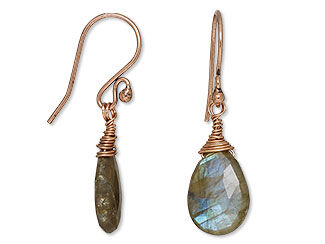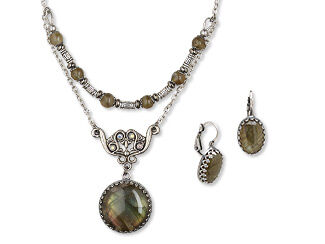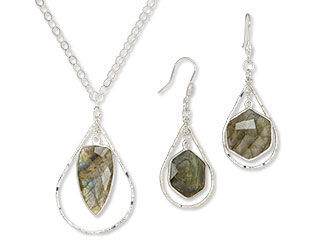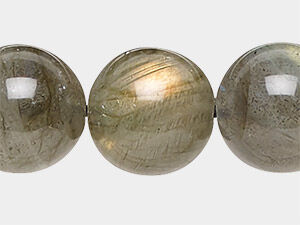Labradorite Meaning and Properties
What is the History of Labradorite?
Labradorite is named for its discovery in Labrador, a province in Canada on the Isle of Paul. According to Inuit legend, a warrior saw the Northern Lights trapped in stone and freed some of them with his spear, leaving the rest behind to shimmer within labradorite. The Inuits revered it as a "fire stone" and used powdered labradorite to treat ailments.
First introduced to Europe in the 18th century by Moravian missionaries, labradorite quickly gained popularity. Though originally found in Canada, labradorite also occurs in Mexico, Russia and Finland. In addition to jewelry, it has been used in road construction, ceramics and glassmaking.
Watch this video and unearth the beauty and legend of labradorite. Discover the history of this stone, where it's commonly found, metaphysical properties and ideas for incorporating labradorite into jewelry designs.

What are the Metaphysical Properties of Labradorite?
Labradorite meaning often ties into spiritual protection and inner strength. This powerful gemstone is considered a guardian of the aura, shielding the wearer from negative influences. It is also thought to restore energy and support emotional healing, making it a favorite for those who tend to overwork.
With its color-shifting quality, labradorite is regarded as a stone of transformation, believed to enhance inner wisdom, willpower and self-worth. It’s also linked with the throat chakra, encouraging clear communication. Though not associated with a specific zodiac sign, labradorite is said to resonate strongly with Cancer.
For added balance, black onyx jewelry is often worn alongside labradorite to ground energy and provide emotional stability, creating a harmonious blend of protection and clarity.
What is Labradorite Made From?
Labradorite is a type of plagioclase feldspar mineral, with a chemical structure of 50–70% calcium and 30–50% sodium. Its most defining characteristic is labradorescence—the brilliant flashes of blue, green and gold that appear under light, caused by twinning within the crystal structure.
Spectrolite, a rarer variety, displays a fuller spectrum of color. These optical effects are caused by light refracting at different angles as it passes through internal layers in the stone.
- Mineral Information: Calcium sodium feldspar
- Chemical Composition: Na(AlSi₃O₈)Ca(Al₂Si₂O₈)
- Color: Grey to blue with green and blue flashes
- Hardness: 6 to 6.5 (Mohs)
- Specific Gravity: 2.69 – 2.70
- Refractive Index: 1.560 – 1.568
How Do You Clean Labradorite?
Labradorite is moderately hard but can be fragile due to its layered structure. Avoid ultrasonic cleaners, steamers, or high heat. Use mild soap, lukewarm water and a soft cloth to clean labradorite safely. To prevent scratches, store labradorite separately in a soft pouch or cloth wrap.
Many designers prefer labradorite for earrings or necklaces rather than rings or bracelets, which are more prone to impact.
To learn more about labradorite and other gemstones, order your copy of Walter Schumann's revised and expanded edition of Gemstones of the World.
Designing with Labradorite
With its luminous glow, labradorite makes a magical centerpiece in jewelry. Labradorite cabochons shine best in open-back settings that allow light to pass through, enhancing their vibrant flash. The gemstone pairs beautifully with sterling or antiqued silver.
Highlight labradorite’s play of color by matching it with complementary gemstones—green prehnite, jade, or emerald for green flashes; aquamarine, apatite, or blue sapphire for blue tones. Designers also love to pair labradorite with black onyx jewelry for bold contrast and elegance.
Labradorite meaning extends to designs intended to channel spiritual growth, transformation, or energy protection—making it a favorite for talismanic pieces and chakra bracelets.
A Few Design Inspirations to Get You Started
In this video, unleash your creativity with this enchanting labradorite gemstone bead tutorial, where glistening beads are strung on beading wire, framing a captivating metal fairy focal as the centerpiece, creating a spellbinding jewelry piece that dances with magic and fantasy!

Shop for Labradorite
**Please note that all metaphysical or healing properties listed are collected from various sources. This information is offered as a service and not meant to treat medical conditions. Fire Mountain Gems and Beads® does not guarantee the validity of any of these statements.
How did you like this resource? Your feedback helps us provide resources that matter to you most.
Copyright Permissions
All works of authorship (articles, videos, tutorials and other creative works) are from the Fire Mountain Gems and Beads® Collection, and permission to copy is granted for non-commercial educational purposes only. All other reproduction requires written permission. For more information, please email copyrightpermission@firemtn.com.







